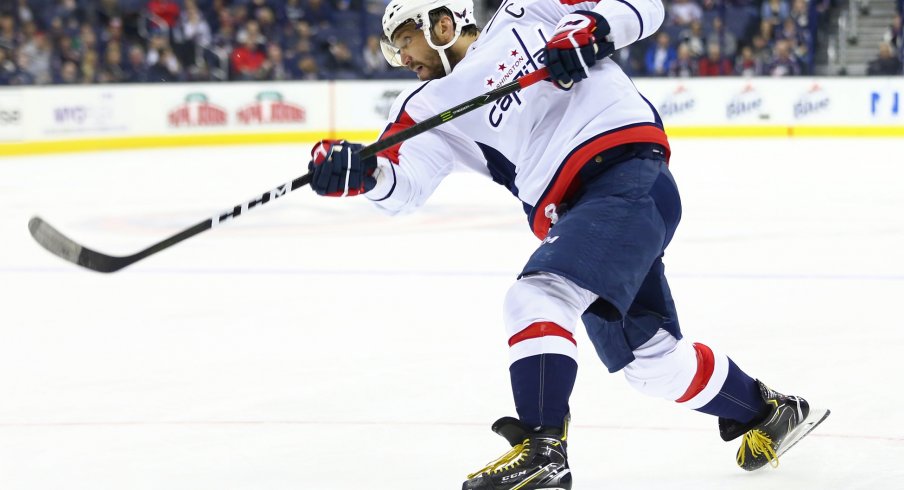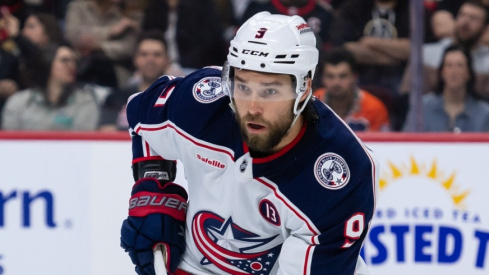The Ovi spot.
It’s one of the most iconic locations on the ice. The left circle. Ovi’s Office. It’s like Mariano Rivera’s cutter – everyone in the building knows the one-timer is coming, and you still can’t stop it.
DjO VI: Stop us if you've heard this one before. Alex Ovechkin from the left circle buries home a slap-shot power-play goal. pic.twitter.com/1DMgKNvlRW
— Sportsnet (@Sportsnet) January 21, 2018
The Blue Jackets and their dreadful 27th-ranked penalty kill will be tasked with shutting down this vaunted unit.
This is not a power play that can be easily stopped; since the lockout shortened 2012-13 season when Adam Oates implemented the 1-3-1 system for the Capitals, their power play has never finished outside of the top 10, and only once, this past season, have they finished outside of the top five. Overall, this has been by far the best power play of the last six seasons.
Arik Parnass, now of the Colorado Avalanche, wrote a piece in 2016 titled: “What Makes The Washington Capitals Power Play So Good?” It’s a tremendous piece that breaks down every part of the Capitals power play from the zone entry to setting up that 1-3-1 formation. The big thing for the Capitals is that they have options; when taking the puck through the neutral zone, if their first lane is covered, they have other options. When they get their power play set up, every player has at least two passing options, plus the option to shoot.
Even if you staple a player to Ovechkin, that just opens up more room for a Nicklas Backstrom or John Carlson.
No one has come up with an effective way to stop the Capitals' power play, and if they have, they certainly aren’t telling anyone. The best way to fend off this power play is to simply stay out of the box.
Over the past six seasons, Washington has averaged 3.13 power play opportunities during the regular season. In 46 playoffs games, that number drops slightly to 2.87. Of those 46 playoff games, the Capitals have an even 23-23 record. In games that they have won they have averaged 3.09 power play opportunities, close to their regular season average. In losses, it’s down at 2.65. That may not seem like much of a difference, but it represents a 16% drop.
The Blue Jackets have been one of the NHL's most disciplined teams this season. They took 223 minor penalties, second fewest in the league, and were one of just four teams to average fewer than seven penalty minutes per game. The Blue Jackets had a penalty differential as a team of +20, meaning they drew 20 more penalties than they took. The Capitals were at –30. That’s a massive 50 penalty difference, and while the Blue Jackets' power play isn’t amazing (though it’s been better recently), if the Jackets are on the power play, it means Washington isn’t.
The Blue Jackets' stars are really good at both drawing penalties and staying out of the box. Artemi Panarin led the team with a +7. Seth Jones and Zach Werenski were each at +4, which put them top 10 among defensemen this season. At the other end, the players that need to be careful are the defense pair of Ian Cole and David Savard. Savard was a -12 and Cole was a very poor -21 between Pittsburgh and Columbus.
In the Capitals 23 playoff wins since 2012-13, they have scored 22 power play goals. In 23 losses, they scored just seven. It’s simple: kill penalties and you have a pretty good chance.
The Jackets' penalty killers are going to need to be aggressive when defending. You cannot afford to let this Capitals group get set up and dictate the play, because ore often than not, they will find an open player and get a high-quality chance. For the Blue Jackets, that means taking away options and forcing the Capitals to make tough plays.
It’s not going to be perfect; the Capitals are certainly going to score some power play goals. The key is to limit the damage.
Stats from Corsica, Natural Stat Trick, NHL.com and Hockey Reference
Follow 1st Ohio BatteryFacebook, Twitter, Instagram and YouTube

